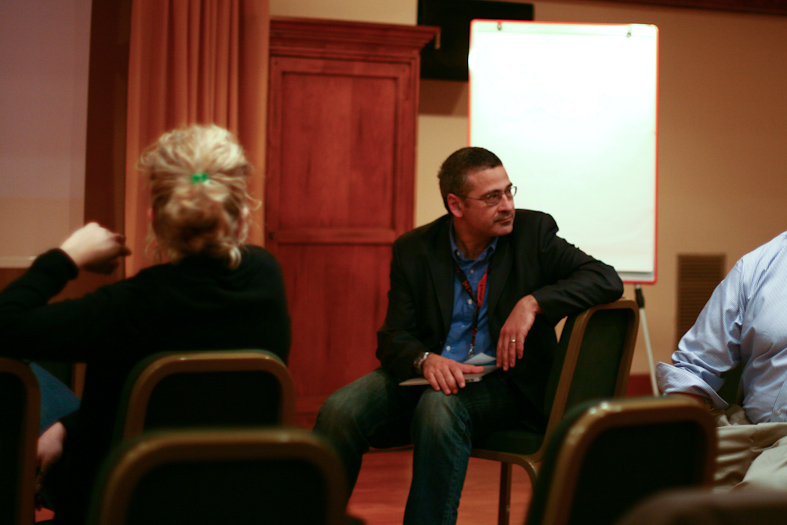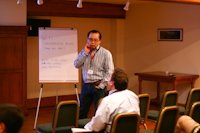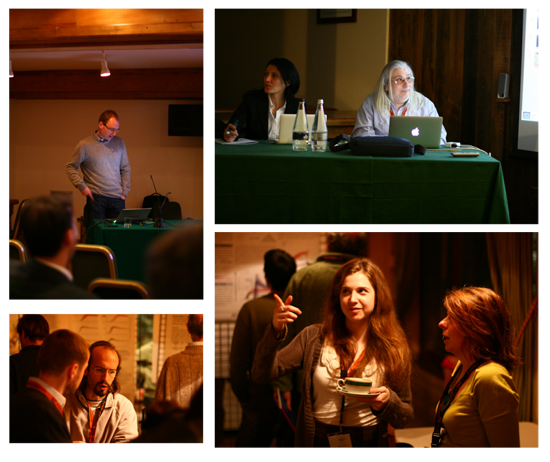talks, outreach
EE² - Epiwork/Epifor 2nd International Workshop - day 2 Jan. 20, 2012
During the second day of the EE2 workshop some of the world’s top scientists of the field gave extraordinary and insightful talks about the epidemic modeling of infectious diseases.
The main topic of the morning session was the analysis of the spatio-temporal spread of influenza with a special attention to the 2009 H1N1 pandemic. By focusing on the incidence data at the US state level, Cecile Viboud, from the US NIH at Fogarty International Center, discussed the role of school openings, seasonal factors and spatial proximity in the unfolding of the 2009 H1N1 pandemic. Gerardo Chowell, from the Arizona State University, tackled the description of the early phase of the H1N1 virus spreading, providing a quantitative description of the age-specific and regional incidence patterns in Mexico and Peru.
 Alex Vespignani, from Northeastern University, discussed the predictive power of large-scale data-driven models. In particular he showed how it has been possible to achieve real-time forecasts with the Global Epidemic and Mobility model (GLEaM) during the unfolding of 2009 pandemic. The work presented by Prof. Vespignani is the result of the collaboration between the Epifor team and the MoBS laboratory at the Northestearn University. In particular, the presentation illustrated the side by side comparison between the epidemiological surveillance data for the H1N1 pandemic peak of more than 40 countries in the Northern Hemisphere (collected by Michele Tizzoni) and the model predictions obtained in real-time and in the after-math of the event, when additional information (such as serological data, detailed timing and coverage of vaccination campaigns, etc) were made available. By using an intensive computational approach it has been possible to test the sensitivity of prediction intervals to the different levels of data integration by considering progressively increasing knowledge of human mobility data and airline transportation networks. The excellent agreement of the model prediction and the surveillance data demonstrated the usefulness of GLEaM in facing the emergence of a pandemic event while the sensitivity analysis finally showed the importance of including the full airline transportation database pointing out the limitations of leveraging on a sampled dataset.
Alex Vespignani, from Northeastern University, discussed the predictive power of large-scale data-driven models. In particular he showed how it has been possible to achieve real-time forecasts with the Global Epidemic and Mobility model (GLEaM) during the unfolding of 2009 pandemic. The work presented by Prof. Vespignani is the result of the collaboration between the Epifor team and the MoBS laboratory at the Northestearn University. In particular, the presentation illustrated the side by side comparison between the epidemiological surveillance data for the H1N1 pandemic peak of more than 40 countries in the Northern Hemisphere (collected by Michele Tizzoni) and the model predictions obtained in real-time and in the after-math of the event, when additional information (such as serological data, detailed timing and coverage of vaccination campaigns, etc) were made available. By using an intensive computational approach it has been possible to test the sensitivity of prediction intervals to the different levels of data integration by considering progressively increasing knowledge of human mobility data and airline transportation networks. The excellent agreement of the model prediction and the surveillance data demonstrated the usefulness of GLEaM in facing the emergence of a pandemic event while the sensitivity analysis finally showed the importance of including the full airline transportation database pointing out the limitations of leveraging on a sampled dataset.
 After the presentation of the GLEaMviz tool, James Kaufman, from the Healthcare Information Infrastructure IBM Research, presented STEM, an open source framework for modeling infectious diseases. By developing ad-hoc plugins, the software can provide insights to policy makers about the spreading phenomena on networked systems, and, therefore, can be tuned to tackle specific issues related to airborne diseases, vector borne, foodborne diseases and zoonosis. In the last talk of the morning session, Dennis Chao, from the Center for Statistics and Quantitative Infectious Diseases, presented a novel method to capture the infection dynamics between cities in terms of matrix operations. In particular he applied this technique to analyze the hypothetical spreading of two competing strains of influenza considering a sample of the air travel connections that includes 321 major cities all over the world, accounting for about 10% of the full worldwide airport network.
After the presentation of the GLEaMviz tool, James Kaufman, from the Healthcare Information Infrastructure IBM Research, presented STEM, an open source framework for modeling infectious diseases. By developing ad-hoc plugins, the software can provide insights to policy makers about the spreading phenomena on networked systems, and, therefore, can be tuned to tackle specific issues related to airborne diseases, vector borne, foodborne diseases and zoonosis. In the last talk of the morning session, Dennis Chao, from the Center for Statistics and Quantitative Infectious Diseases, presented a novel method to capture the infection dynamics between cities in terms of matrix operations. In particular he applied this technique to analyze the hypothetical spreading of two competing strains of influenza considering a sample of the air travel connections that includes 321 major cities all over the world, accounting for about 10% of the full worldwide airport network.
The afternoon session shifted the attention from human infectious disease to livestock diseases. Rowland Kao, from the University of Glasgow, discussed the potential of the whole genome sequencing (WGS) tools to study the transmission dynamics of observed epidemics involving a large unsampled “reservoir” host, as is the case for bovine tuberculosis in British cattle and badgers. Thomas Selhorst, from the Friedrich-Loeffler-Institut, presented the analysis of German swine trade movements and the computational analysis of emerging infectious disease spreading among livestock premises.
 Two parallel round tables took place in the second part of the afternoon. The one chaired by Elizabeth Halloran from the University of Washington, revolved around the modeling of vaccine efficacy as well as the issues related to the vaccine efficacy evaluation. In the meanwhile, Armando Giovannini from the Istituto Zooprofilattico Sperimentale, led the stimulating and interactive discussion about livestock infectious disease modeling and the role of data gathering and sharing in the perspective of a supranational preparedness against emerging zoonoses.
Two parallel round tables took place in the second part of the afternoon. The one chaired by Elizabeth Halloran from the University of Washington, revolved around the modeling of vaccine efficacy as well as the issues related to the vaccine efficacy evaluation. In the meanwhile, Armando Giovannini from the Istituto Zooprofilattico Sperimentale, led the stimulating and interactive discussion about livestock infectious disease modeling and the role of data gathering and sharing in the perspective of a supranational preparedness against emerging zoonoses.
Neil Ferguson, from the Imperial College, closed the second day of the workshop with a dinner talk presenting a highly structured model for the study of malaria across Africa. The model incorporates climatic ingredients and couples the ecological and environmental factors related to the vectors and population dynamics. It has been used to assess the impact of different intervention strategies aimed at the elimination of malaria demonstrating the feasibility of eradication in a long-term perspective.

Posts by category: awards/honors, news, outreach, publications, research, talks, team news



